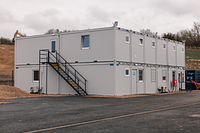The Benefits of Using Modular Buildings for Educational Facilities
Experience the benefits of modular buildings for educational facilities: quick setup, flexibility, cost-effectiveness, and customisable design for optimal learning environments.

Modular buildings have become increasingly popular in recent years due to their flexibility, affordability, and speed of construction. One area where modular buildings have seen significant growth is in the education sector. Here are some of the benefits of using modular buildings for educational facilities:

1. Quick construction
One of the biggest advantages of using modular buildings for educational facilities is their speed of construction. Modular buildings are built off-site, which means that construction can take place concurrently with site preparation. This reduces the overall construction time, which is especially important in cases where the school needs to be completed quickly, such as in emergency situations.
2. Flexibility
Modular buildings are highly flexible in terms of design and layout. This means that educational facilities can be customised to meet the specific needs of the school. For example, modular buildings can be designed to house classrooms, laboratories, administrative offices, and even gymnasiums.

3. Cost-effective
Modular buildings are typically less expensive than traditional construction methods. This is because the manufacturing process is more efficient, and there is less waste generated during construction. Additionally, modular buildings require fewer workers to construct, which reduces labour costs.
4. Energy-efficient
Modular buildings are designed to be energy-efficient. The modules are constructed in a factory setting, which allows for greater control over the building process. This means that modules can be designed to be more airtight, and insulation can be installed more precisely. This reduces energy consumption and lowers utility costs.

5. Minimal site disruption
Modular buildings cause minimal site disruption during construction. This is because the majority of the construction takes place off-site. This means that there is less noise, dust, and debris generated during construction, which minimises disruptions to the school and surrounding community.
6. Sustainable materials
Modular buildings can be constructed using sustainable materials, such as recycled steel and low-emission materials. This reduces the environmental impact of the construction process and promotes sustainability.

In conclusion, modular buildings offer a range of benefits for educational facilities, including quick construction, flexibility in design, cost-effectiveness, energy-efficiency, minimal site disruption, and the use of sustainable materials. By choosing modular construction for educational facilities, schools can achieve their construction goals quickly and cost-effectively, while still providing high-quality facilities for students and staff.
You may also be interested in...

How to Choose the Right Modular Building for Your Specific Needs
Find your ideal modular building layout with our expert team's guidance. Offices, schools, healthcare facilities, and more.

The Advantages of Hiring a Modular Building over Buying
Flexible and affordable modular buildings for hire. From temporary offices to long term healthcare facilities.

Accessibility and Safety Features of Modular Buildings
Explore the vital safety and accessibility features of modular buildings. Creating a secure and comfortable space.
